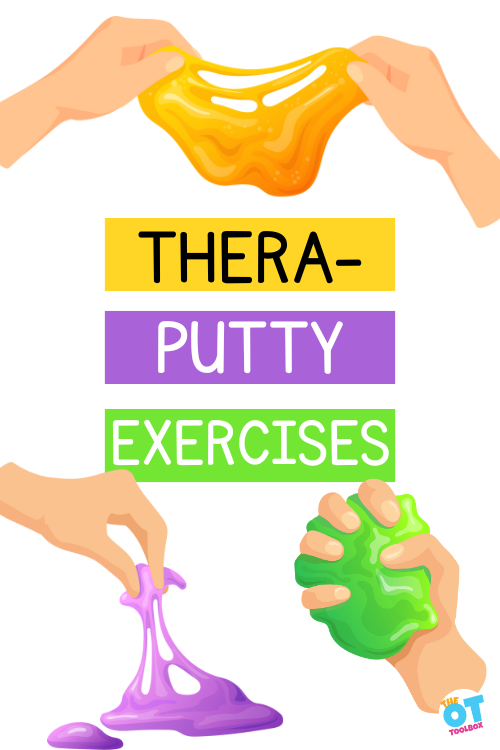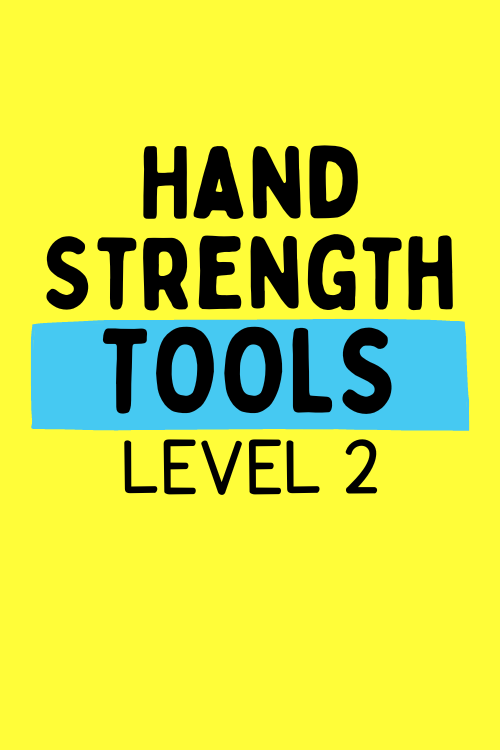In this blog post we’re covering all things theraputty exercises! Therapy putty, or theraputty, is a resistive putty material that occupational therapy providers intertwine with play to create a hand strengthening exercise that kids LOVE. You can also target specific aspects of fine motor work to specifically incorporate finger strength exercises in a play-based manner. (i.e. using the theraputty to make play dough snakes, putty snails, or other fun putty shapes!)
You’ll also want to check out our favorite slime exercises for strengthening pinch and grip strength, with a tactile sensory touch aspect.

TheraPutty Exercises
Finger strength is important for children when they perform daily living activities such as eating, dressing, writing, bathing, oral hygiene, school tool management, technology use, and many other daily tasks.
Children need to be able to perform these tasks as independently as possible so that they feel confident and prepared for their daily routines.
As children age, more expectations make hand and finger strength essential.
One way to build these skills is with a therapy tool called theraputty.
Therapy putty is a resistive material, much like silly putty, that has a range of resistances, depending on the color of the putty.
Theraputty is an excellent tool that can be utilized by all ages. It helps to provide a fun way for children to work on strengthening the muscles of the fingers, hands, and forearms.
Just keep in mind that in general, therapy putty exercise progress can be gauged by beginning with 10 repetitions for each exercise that the child needs to work on and have them work up to 3 sets of 10 reps for each exercise before you switch them to the next resistance level.
Putty Exercises: These grip strength exercises are some of the ways to encourage stronger hands in functional tasks. These exercises target the intrinsic muscles of the hands.
Finger hook is a putty exercise in which a ball of putty is in the hand and the child hooks their fingers around it and presses their fingers deeply into the ball. This is a great exercise for targeting a hook grasp.
Thumb press is an exercise in which a ball of putty is placed in the palm near the base of the thumb and the child grips and presses their thumb deeply into the ball.
Full hand grip is a complete hand exercise in which a ball of putty is in the palm of the hand and the child slowly squeezes the ball making it ooze out around the fingers and thumb.
Piano fingers is an isolated finger exercise in which a log of putty is in the palm of the hand and the child slowly squeezes one finger at a time into the log.
Pancake stretch is a whole hand exercise in which a pancake piece of putty is placed on the tips of the fingers and thumb and the child slowly spreads their fingers outward stretching the putty out while doing so.
Finger pinch is an isolated finger to thumb exercise in which small balls of putty are placed between each finger and the thumb, one at a time, and the child squeezes each ball as flat as possible between each finger and the thumb.
Scissor fingers is completed by inserting a 1” thick ball of putty between each pair of fingers and the child attempts to squeeze the fingers together as close as possible.
Log press is completed by making a log of putty and placing on the table top. The child follows by inserting each finger one at a time into the putty.
Pancake pinch is completed by making a pancake of putty and placing on the table top. The child follows by inserting their fingers into the putty and pulling the putty upward with pinching motion making the putty appear more like a pyramid.
Thumbs-up extension is an exercise in which a loop of putty is placed around the thumb and then the child pulls their thumb upward stretching the putty slowly as they do so.
Fingers-up extension is an exercise in which a loop of putty is placed around each finger, one at a time, and then the child pulls their fingers upward stretching the putty slowly as they do so.
Theraputty Activities
Therapy putty is engaging and its use can be very a versatile therapy material with minor changes implemented to make it appealing to multiple ages. For younger children, therapy putty activities are preferable, because the activity is motivating and engaging. For some kids on my OT caseload, theraputty activities are some of the most engaging!
- Bury beads in theraputty- For instance, if children bury fun beads into the putty, they are working on finger strength and dexterity as they bury and retrieve those beads by digging them out. This is a great activity for younger kiddos who are not yet ready to engage in direct putty exercises. Extend the activity by using letter beads. When kids find the letter, they can write it on paper to practice handwriting skills. Then ask them to write a word or a sentence using that letter for more advanced writing tasks.
- Press stamps into theraputty- A few other fun young kiddos activities could be pressing picture stampers into the putty to make fun animal scenes.
- Create putty animals- Another would be creating therapy putty animals such as a building a caterpillar, porcupine, or a cute snail. They can be creative and come up with their own ideas too!
- Make theraputty flowers- Another could be inserting small pony beads into a putty blob or putty pancake for a child to create cute flowers. Simply just think about these terms while having a child engage in putty activities: squeeze, press, poke, stretch, pinch, twist, and roll. All of these can help build hand and finger strength.
- Push coins into theraputty- One activity I love is to push coins into the putty in a key grasp to build in-hand manipulation skills needed for managing coins, much like those needed for pushing a coin into a vending machine.
- Make a putty snake- Creating a play dough snake only with putty is nice because of the added resistance offered by therapy putty.
That is a quick review of younger kiddo activities. Now, let us look at some actual therapy putty exercises for older kiddos that can help them build hand and finger strength as well as endurance which are some of the foundational skills needed to help them be successful in their everyday life functions.
how to remove theraputty from clothes
Therapy putty is a fun and stretchy means for building hand skill as well as strength and endurance. But here is a warning to you, DO NOT get putty on fabrics as it is very difficult, if not impossible to get out. This has been learned the hard way and one of us has a bright red blob of putty on their favorite pair of jeans! UGH!
So, watch it as it is being used and keep threads of putty and pieces of small putty off clothing and other fabrics (like furniture and carpet, etc.) it will ‘melt’ its way into it and then it is over as you will have a new colorful embellishment! You should also watch where the theraputty is being placed on the table. If it’s too close to the edge of the table, the putty will “melt” over the sides and onto the floor or anything in it’s way.
To get theraputty out of clothes or fabrics when the situation arises, try these strategies:
- First, scrape the putty away from the clothing or fabric using your fingernail or edge of a spoon.
- Then, pat and quickly pull a ball of putty into and away from the spot on clothes to remove as much as you can by attaching the putty to the putty ball.
- When you’ve removed as much as you can from the fabric, spot clean the area with Isopropyl Alcohol or hand sanitizer. Dab the alcohol solution onto a cotton ball or rag. Hold it over the spot for about thirty seconds. Then rub and try to scrape off the putty material.
- You can also try a material like Goof Off on the spot.
Theraputty Tips
You can purchase therapy putty from Amazon or from therapy supply stores that specialize in these products.
A quick note, if you do purchase the putty, it will allow you to pick your resistance levels from extra soft to hard and give you a better way to show a child’s progress in hand and finger strength when writing progress notes.
Some other general therapy putty advice that will help prolong the use of the putty:
- Have client wash their hands before and after using to keep it clean and avoid any cross contamination.
- Use a clean table top surface free of any fabrics.
- If a child has difficulty touching the putty due to the feel of it, place it inside a plastic baggie for them to manipulate the putty as much as they can. Try to build their tolerance.
- Always supervise a child while using to prevent eating by a child or even a pet! Keep the putty away from hair, clothing, rugs, and carpet. It is a sneaky little thing that tries to blend away sometimes.
- Usually yellow, red, and green putty resistance levels are used with kiddos, but a few kiddos need something different. Just be sure to check each companies’ resistance levels to be certain of what you are buying to support your caseload or kiddos.
For more hand strengthening exercises, also try these handwriting warm-up exercises:

Members of The OT Toolbox Member’s Club can get access to all of our hand strengthening tools including:
- Fine motor plans
- Hole punch activities
- Clothes pin activities
- Play dough paper clip activities
- Push pin activities
- SO much more
Join The OT Toolbox Membership today!

Regina Parsons-Allen is a school-based certified occupational therapy assistant. She has a pediatrics practice area of emphasis from the NBCOT. She graduated from the OTA program at Caldwell Community College and Technical Institute in Hudson, North Carolina with an A.A.S degree in occupational therapy assistant. She has been practicing occupational therapy in the same school district for 20 years. She loves her children, husband, OT, working with children and teaching Sunday school. She is passionate about engaging, empowering, and enabling children to reach their maximum potential in ALL of their occupations as well assuring them that God loves them!






